The Google Nexus 9 Review
by Joshua Ho & Ryan Smith on February 4, 2015 8:00 AM EST- Posted in
- Tablets
- HTC
- Project Denver
- Android
- Mobile
- NVIDIA
- Nexus 9
- Lollipop
- Android 5.0
Software
With the Nexus 9, Google has released the biggest upgrade to Android since 4.0. In some ways, Android 5.0 represents one of the biggest shifts in the design of the OS ever. While we’ve had JIT compiling on Dalvik since Android 2.2, this has remained largely static for the past few years during Android’s monumental growth. With Android 5.0, we see the introduction of Android Runtime, or ART. Instead of trying to compile the application right before execution, ART does most of the compilation well before the application is launched. This incurs higher storage requirements, longer app-install times, and longer first-boot times, but with great benefits to performance. Google has done a great deal of work in general to try and resolve performance issues, as we first detailed in our coverage on ART.
While performance is one major aspect of Android 5.0, Google has also fundamentally redesigned the interface. To replace Holo, Google has introduced Material Design, which emphasizes depth, physics, animation, and a new palette of colors. While it would be great to go over all of these aspects of the Nexus 9, it’s best to refer to Brandon's review of Android 5.0 Lollipop for these issues. Instead, for this review I will mostly focus on the Lollipop experience specific to the Nexus 9. This means that the focus will be on performance of the device in general usage, along with the app ecosystem for Android tablets.
Unfortunately, these seem to be sore points of the Nexus 9 and the broader Android tablet ecosystem. Without question, if we’re talking about tablet applications they definitely do exist for the Nexus 9. The problem is that there is a pervasive lack of applications that are truly designed for a 9 inch, 4:3 aspect ratio display. Applications like Twitter, Facebook, and other first-party apps are simply blown up versions of the phone application. There is some level of extra content presented, but a lot of applications just don’t scale correctly which wastes a lot of real estate on the display. While we found issue with the Nexus 6’s lack of phablet-specific layouts, this is an even bigger issue on the Nexus 9.
While it’s possible to point fingers at app developers for not supporting Android properly, Google seems to have these problems as well. The settings interface is a single large pane of options, instead of a dual-pane interface that allows for simultaneous navigation of the overall settings and individual settings. The Play Store application is mostly similar in this respect, and the YouTube app is possibly the worst example of these kinds of issues. For example, while there is a tablet-specific video view in landscape, most navigation, search, and video selection is identical to what we see on a smartphone.
Nothing really takes advantage of the screen size other than simply being bigger than before. There aren’t any multi-window modes that exploit the larger screen size, and in general the Nexus 9 doesn’t introduce any new functionality that clearly justifies the need for a bag/backpack to carry it. There are applications that take advantage of the larger display, but these are rare. For the most part though, this is effectively true for most tablets other than the Surface Pro 3 which is effectively in a different category altogether.
On the performance side, the story is better but it isn’t perfect either. Similar to Brandon’s experience with the Nexus 6, I often saw random stutters on animations such as the app drawer or while opening an application. It’s hard to say what the cause is at this point, as the Nexus 6 seems to have similar issues with lag even though the Nexus 5 has none of these issues. One might point to FDE causing worse performance, but even that isn’t quite accurate as a build of Lollipop with FDE disabled didn’t do all that much in the way of solving these problems. Overall though, the experience is somehow less performant than the SHIELD Tablet on Android 5.0, even if these issues mostly present themselves in the form of minor frame drops from time to time. I also noticed that there was a distinct lack of available memory over time, which suggests a memory leak as on reboot launcher redraws effectively disappeared.
While these are significant issues that need to be resolved, the experience isn’t actually as bad as it seems. For what it’s worth, Material Design is a great new design scheme to replace the somewhat dated Holo UI that has been in use since Honeycomb/Android 3.0. While there are issues with the tablet experience, if one is willing to look past these issues they will find that the Nexus 9 is a respectable software experience. There’s also the potential for the Nexus 9 to spur improved tablet experiences, although this would be a slow change that could take years to be meaningful.


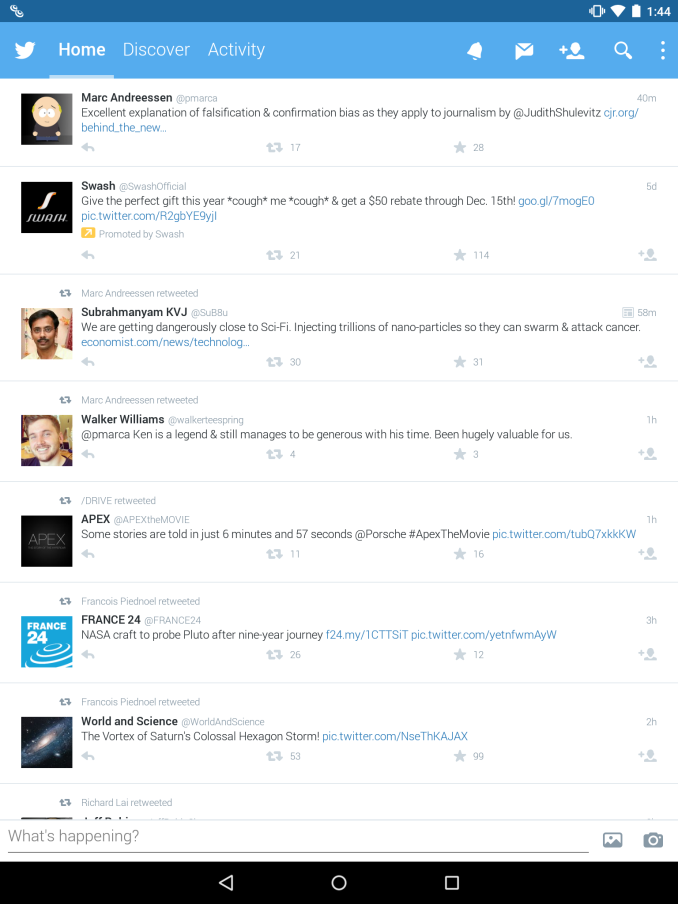
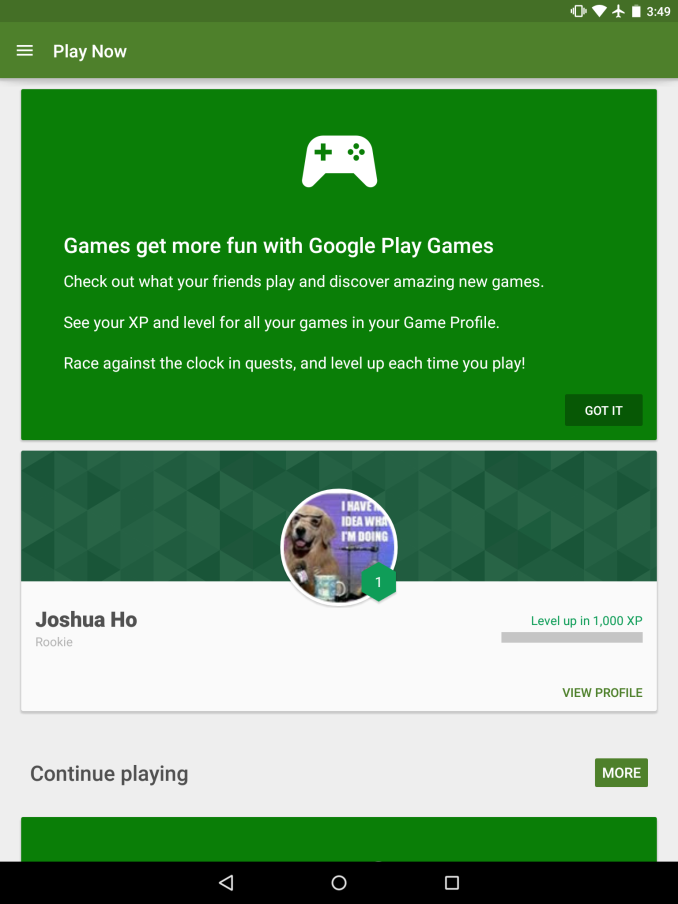
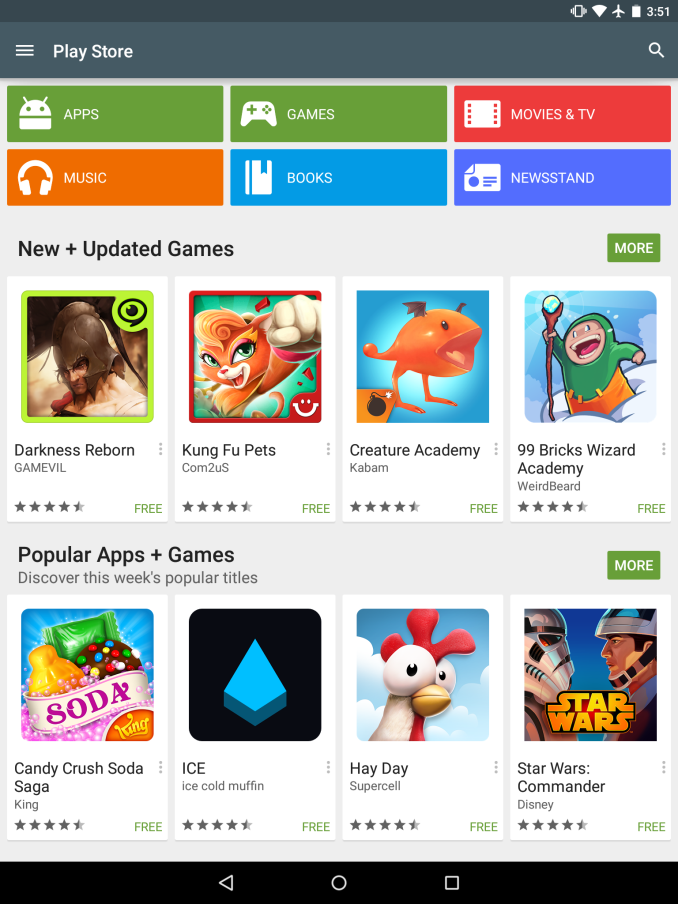
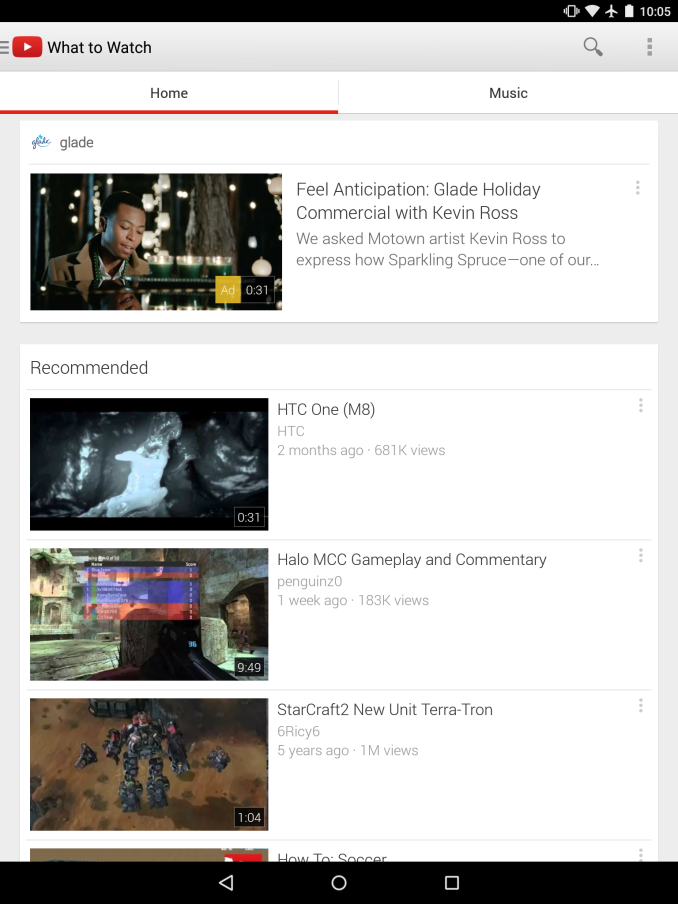
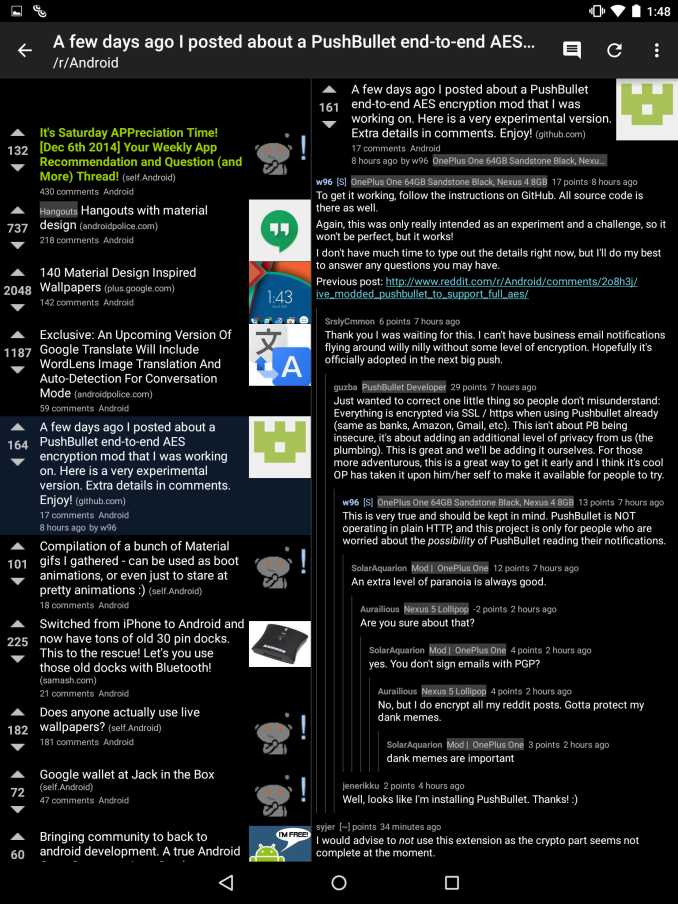








169 Comments
View All Comments
UtilityMax - Sunday, February 15, 2015 - link
I don't fully understand you comment about the SoC? You think web browser is using the hardware somewhat differently from the dedicated apps?My comment is about the fact that there is not point to have most of the dedicated apps when you have a tablet with a screen the size of a small laptop or netbook. Just fire up the web browser and use whatever web site you need. Most dedicated mobile apps exist because the screen size of a cell phone is pretty small, which can make for an awkward experience even when you pull a mobile web site though a web browser.
UtilityMax - Sunday, February 8, 2015 - link
It's not entirely true that there isn't much in the tablet space, besides Nexus 9 and Galaxy Tab S. If your pockets are deep enough, you could always get the Apple iPad Air 2. Apple gives you a well balanced tablet with great build quality, fine screen, CPU/GPU performance, and battery life. The only thing that's missing is an SD card slot, but at least there is an option a 64 or 128GB model. Personally, I ended buying a Tab S 10.5 because it was truly difficult to resist it at only $400 sale price, plus $35 for a 64GB SD card. Despite all the disappointing benchmarks, Tab S provides a pretty smooth and fluid android experience with a great screen. Battery life is the only thing that's getting on the way. Five hours of web browsing or standby is pretty disappointing.wintermute000 - Monday, February 9, 2015 - link
Sony Xperia Tablet Z2. SoC is one gen behind but if you can get it for a good price, you're laughing. Fantastic build, clean stock software, lag free.sunil5228 - Sunday, February 8, 2015 - link
Brilliant ! Esp loved the segway into the Denver CPU and dual vs quad arcitechture comparisons,very eye opening. thankyou sirbdiddytampa - Wednesday, February 11, 2015 - link
Picked one of these up a couple weeks ago and love it. It performs phenomenally well, and looks great. It's a bit heavy for its size and the thin bezel on the sides makes it difficult to hold with one hand without touching the screen, but overall its a fantastic tablet. Highly recommend it.Ozo - Monday, February 16, 2015 - link
Thanks for the lucid explanation of Denver.Any insight into why Google/HTC dropped the ball on "wireless" Qi charging? Especially when it was finally added to the Nexus phone!?!
I was set to upgrade from my Nexus 7 (2013), but no Qi = no sale. :(
Fardreit - Monday, February 23, 2015 - link
I'll be honest: I don't understand 80% of what the reviewer wrote. But the 20% that I do understand is enough for me to appreciate the conclusions drawn. I value the informed reviews here much more than those at the 'fan' websites. At Anandtech, people really know what they're talking about, even if I don't.When I'm able to follow the high-tech insults you guys sling at each other, then I know I've made progress.
flashbacck - Wednesday, February 25, 2015 - link
Does the Shield Tablet use a similar DCO? I have noticed during it has performance issues during regular use. I wonder if it's this DCO that still needs work.ahcox - Thursday, February 25, 2016 - link
What is the accuracy of the image labelled "K1-64 Die Shot Mock-up"? Is it a colorized and enhanced version of a real die photograph or is it a pure invention? That 16 * 12 array dominating the picture seems a little off to me: surely there should be structures common to each 16*2 group forming an SMX? Kepler is not a simple tiled sea of cores.